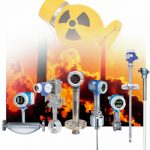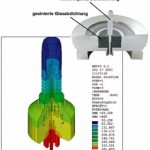In chemical process engineering, temperatures of up to 300 °C are nothing unusual when it comes to petrochemical applications. In addition to the standardised mechanical methods, the chemical supply industry today still uses predominantly classical measuring principles for these extreme conditions, such as flow measurement with orifice plates and level measurement with differential pressure or displacers. However, proven measurement methods such as radar, TDR (guided radar), Coriolis and vortex are also gaining ground in this industry.
Wolfgang Lubcke
Process-related parameters, such as level, flow and pressure, are still mostly recorded using classical measuring principles. Mechanical principles are also often employed. Plant owners endeavour to cover the wide range of parameters to be recorded with as few measuring systems as possible. One example of this can be seen in the differential pressure transmitters which are used to measure flow, level and pres-sure. However, despite their transparency and standardisation, mechanical methods such as displacers, floats or oval wheel meters require a lot of maintenance and have a high rate of wear. Furthermore, the accuracy of these measuring principles is to some extent dependent on the density and temperature of the medium. As a result, those responsible for planning refurbished or new plants are starting to take modern measuring technology into account.
Modern technology
Endress+Hauser has established itself in the chemical industry as a full provider of field devices for all parameters relevant to the process, such as flow, pressure, level limit, level, temperature and liquid analysis. To enable these tried-and-tested technologies, such as vibration measurement, Coriolis mass measurement, vortex and radar/TDR (time domain reflectrometry), to be designed for high-temperature and high-pressure applications, the sensors and transmitters have to be improved and adapted. A lot of technical know-how is required to make these adjustments, since they start with the choice of sensor material and range from the use of optimised filling oils with low temperature coefficients to the electrical connections – which represent the real challenge for the dependability of high-temperature field devices.
Classical versus hi-tech
Apart from recording the mass flow, the latest generation of Coriolis flowmeters also simultaneously records several parameters of the medium, namely density, temperature, volume, concentration and viscosity. Such varied information cannot be gathered from the process using conventional measuring techniques, such as a pitot tube or an orifice plate measurement. For this reason, the benefits of these additional process variables must also be taken into account when directly comparing the costs of Coriolis mass measuring devices with classical, volumetric methods. The high-temperature model in the Coriolis family has a compact design (DN 25 / 50 / 80) and can be used at temperatures up to 350 °C. Measuring tube materials such as Alloy C-22 and a temperature spacer between the sensor and electronics ensure the unit is safe to use at these high temperatures.
Vortex flow measurement
Capacitive sensor technology with the patented DSC (differential switched capac- itance) sensor is at the heart of vortex flowmeters (up to 400 °C). The complete sensor is made of stainless steel and thus – in contrast to sensors with piezoelectric crystals – has absolutely no parts which are sensitive to temperature. Specified components, which can be operated at temperatures of up to 125 °C, are used for the pre-amplifier which is closest to the process. In steam applications, in particular, high temperatures mostly occur in conjunction with high pressures. For these measuring points, the parts of the sensor bearing pressure and in contact with the medium are manufactured from Inconel, a material used in aerospace engineering. In addition to the volume flow, the vortex meters with integrated temperature measurement also record the mass flow and corrected volume flow.
Special filling oils with low expansion coefficients suitable for use at high temperatures are used for pressure and differential pressure sensors, and since the seal is often the most critical weak point at such temperatures (up to +350 °C), it is completely welded. The materials in contact with the process meet all requirements with regard to corrosion resistance and resistance to stress corrosion cracking in acid gas applications (NACE MR 01–75). Prefabricated, ready-to-install differential pressure measuring systems made of special materials (15Mo3), which work according to the differential pressure method, are deployed in high-pressure ranges.
The vibration measuring principle is over 20 years old and established in all areas of industry. The following technological modifications were incorporated for use at constant high temperatures (up to 280 °C):
- A special piezo material is used to actuate the tuning fork. The cores of the electrical connection to the drive are „baked“ into the piezo material.
- Duplex steel has proved to be suitable at a load of 64 bar pressure and 280 °C. It has a small expansion coefficient and a high mechanical loading capacity.
- A temperature spacer, the entire inner tube of which is designed as a flameproof enclosure, ensures the necessary distance between the electronics and the process.
Radar technology
Contactless radar technology is especially distinguished by the fact that is independent of the prevailing process conditions. Today, the levels of liquids in the temperature range from –60 to +400 °C (0 to 160 bar) can be measured continuously with the freely emitted electromag-netic waves. In the high-temperature version of the radar sensor, the high-frequency coupling in the antenna is made of ceramic (Al2O3) and sealed with graphite packing; the other parts of the sensor are made from high-grade steel.
Another radar technology variant comprises electromagnetic pulses guided on a rod, for example, for continuous level measurement of liquids at very high pressures and temperatures (-60 to +400 °C, 400 bar). Measuring points in measuring chambers (bypass) are often found in the oil, gas industry and petrochemical industries. Practically maintenance-free TDR provides the ideal requirements here with the rod probe and ensures reliable measurement right up to the top of the chamber. Other typical applications are level measurement in the event of slight foam formation and changing media as well as tanks with complicated geometry. The electronics are once again protected against overheating by means of a temperature spacer.
The outstanding advantages of radiometry are most evident in applications where extreme process conditions prevail (high temperatures, high pressures, etc.) or where no additional process connections are available for measuring technology. Gamma rays are used to determine levels whenever other measurement methods, including high-temperature versions, no longer work satisfactorily. The measuring system detects levels externally, without any contact whatsoever, through the container wall and is therefore the standard solution both today and tomorrow for special applications in the chemical and petrochemical industries.
Temperature measurement up to 1600 °C
Thermocouples for the high-temperature range are equipped with a metal or ceramic protective tube, thus ensuring an optimum service life even under the most extreme process conditions. Depending on the temperature, the metal shell is made of special alloys or steels in the AISI 310 and AISI 446 series or of Inconel 600 (up to 1100 °C). Ceramic shells (KER530, KER610, KER710) are used for temperature ranges above 1100 °C or if the medium contains gases which could contaminate the thermocouples. The thermocouple is optimally protected by the tube and it is possible to replace or check the gauge slide without interrupting operation. Field transmitters with redundant signal inputs guarantee the availability of the measuring point even if one thermocouple fails.
Redundant process seal
Flow, pressure, level limit, level and temperature measuring points for the high-temperature and high-pressure range generally have a redundant process seal to prevent media leaking in the event of a failure. Examples include flameproof cable glands or additional secondary containments. In addition to these safety aspects, more and more attention is also being paid to eco-nomic factors when comparing classical to hi-tech methods. The hi-tech measuring principles, which have meanwhile been tried and tested, offer clear cost advantages not only at the time of purchase but particularly during operation, since regular maintenance cycles can be significantly longer than with mechanical processes.
cpp 436
Share:









